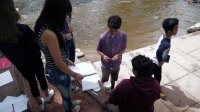Answers That Are a Little Out of Reach
With inquiry-based learning, middle school science students use experiments and discussion to stretch their thinking.
Overview
Inquiry-Based Learning in the Science Classroom
Inquiry-based learning uses a central question to frame a curriculum unit or module. Students answer this central question for themselves, discovering and learning through a series of guided discussions, experiments, and hands-on activities over several class periods. Teachers find that students are more engaged in what they're learning, and have a wider context for understanding the material rather than just hearing a lecture or memorizing facts.
Ian Schwartz, a science teacher at Casey Middle School, says:
How It's Done
Designing an Inquiry-Based Lesson
To design an inquiry-based module, teachers at Casey Middle School use a central question to frame a series of classes. Every class is then organized to help answer that question through readings, hands-on activities, group work, and student discussions. A good central question can frame several classes, or can even take weeks to answer as students work to piece together their learning and understanding of the subject matter.
At Casey MS, a good starting point is the Boulder Valley School District Adopted Standards. The standards are used to form big questions (i.e. How does where you live affect how you live?), which can then be broken down into more specific questions that speak to a particular theme or unit. For example, eighth grade students take earth science, which is divided into four curriculum units during the year:
- Atmospheric science and weather
- Earth systems
- Space science
- Energy resources.
Each unit can have a central guiding question, or can be broken down even further into modules with mini guiding questions.
Sample Question and Lesson Plan
"Would you recommend to friends visiting from out of town that they tube in Boulder Creek?"
In Ian Schwartz's science class, students look at whether their neighborhood creek is clean enough to tube in. All students at Casey MS know the creek as a place for recreation, often going there with friends and family on the weekends. By connecting students' learning to something they are familiar with, Ian has made the learning relevant and utilized the Boulder community as an outdoor classroom. He says:
During week one, students talk about the cycle of water in the Boulder community, the limited supply, and how it gets treated and reused by the community. Week two starts with a class lecture and discussion on the types of pollutants that might be in water. Later in the week, students are introduced to basic water tests and water sampling. They also begin to hypothesize and discuss what they think about the "answer" to the Boulder Creek question. Some students think the water is healthy because it is clear, and therefore safe to tube in. Others are not so sure. All observations and hypotheses are recorded in students' science notebooks.
The week concludes with students going to the creek to sample and analyze the water. They use LaMotte water-testing kits and to test for things like dissolved oxygen, the pH of the water, and nitrates and phosphates. While at the creek, they compare their findings to a chart that gives them some qualitative measures of how much dissolved oxygen is in the water, and whether or not that falls into a healthy bracket. In addition, they record things like the day's weather, the air temperature, and the water temperature, all of which may affect the creek's water quality.
During the third week, students compare their data with other groups, and start to get a picture of what's going on in the creek. They also start to work on their final presentations, a lab report, and an infographic (electronic poster) about their findings and conclusions, ultimately answering the question about whether they would recommend whether friends should tube in Boulder Creek.
Inquiry-Based Learning vs. Hands-On Learning
Inquiry-based learning utilizes hands-on learning, but not all the lessons pertaining to the central question are hands-on. Though hands-on strategies are often integrated, sometimes inquiry-based learning is about reading material, discussing it with other students, or doing some research. Hands-on learning (like we saw at Boulder Creek) is part of the experience, though not all classes will be hands-on in an inquiry-based learning unit.
